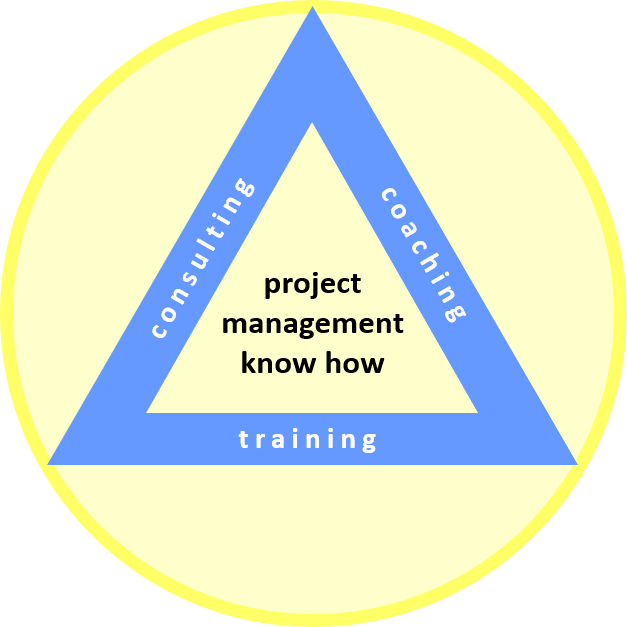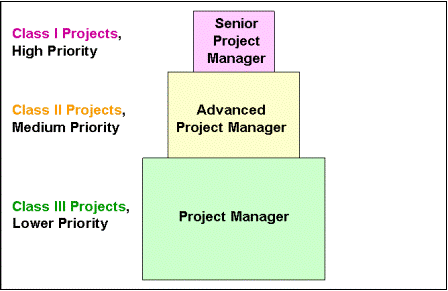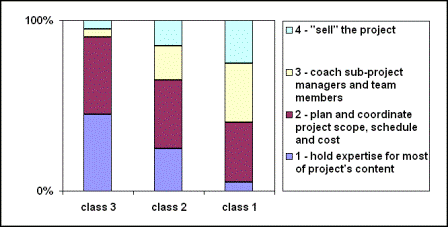- Home
- Project Portfolio
- Project Management Career Model
Project Management Career Model
Published: 2010-06-21
Last updated: 2022-03-20
A well structured project management career model is key to hiring talents and retaining best-in-class project managers. On this page we explain why it is important and how it should look like.
Pursuing certain career goals and climbing the corporate ladder has many different aspects: Do we prefer to follow a line management career or the path of expert consultants or a project management career?
Based on our academic education, most of us join a company or government organization and begin our careers as experts: in electrical engineering, in mechanical engineering, in construction engineering, in business administration, in some special area of mathematics, physics, chemistry, biology, geology, geography, in psychology, in sociology, in interior design, as lawyers, as technical advisors, as sales representatives, in movie production, in advertising, in product marketing, in public relations, … This list of different areas of expertise is virtually endless, but one thing we have in common: we start our professional lives as experts in organizations that offer challenging, attractive tasks, and manage ourselves and our work.
Along the course, many of us join project teams and contribute to more or less successful projects. We realize that the work of a project manager is also challenging and attractive.
Further down the road, some of us take responsibilities of managing the one or the other smaller project, coordinating team members and planning their work.
After a couple of years and accumulating a lot of experience, the projects we manage become more complex and larger until a few of us take over responsibilities of leading and managing very large projects and find ourselves quite close to our organization’s top level management, reporting directly to them.
We make our choices in a private and professional environment that holds a lot of surprises: unexpected opportunities, sudden halts, side steps, back steps, assignments in foreign countries in different cultural surroundings, and more. Our motivation to remain on a certain career path is closely connected with the challenges we face and the support we get from our organization. A project management career model with clear job descriptions for each one of the career steps provides that necessary support.
Main Characteristics of a Project Management Career Model
Main characteristics of such a career model are:
- Basic structure
- Job descriptions
- Salary and benefits
- Incentives
- Personal development of project managers
Basic Structure
A project management career model shall be closely connected to a corresponding project prioritization framework as we describe in sub-section Project Prioritization.
The majority of projects will be in priority class III. Thus, we need a majority of project managers on the project manager’s level. Likewise, we need less on the level of advanced project managers, and only a few on the level of senior project managers.
Project Management Job Descriptions
We need job descriptions in order to be able to differentiate between the different levels of that project management career model.
If, for example, an advanced project manager wants to move on to the next level, then this is equivalent to a promotion based on the project management career model. There must be a clearly communicated set of evaluation criteria in terms of professional and life experience and expected results on each level. It is best practice to set these evaluation criteria in job descriptions including comments and examples. We would like to emphasize that we rest each promotion upon an evaluation - or even assessment - of the candidate’s ability to fulfill the requirements of the job profile of the target position.
What are the main differentiating aspects?
As with project prioritization, we differentiate the job descriptions in terms of
- organizational benefits (revenue, cost, profit, and improvement of image),
- complexity (necessary expertise, innovative content, contractual relationships, cross-cultural communication, work in virtual teams),
- risk value (damage to the organization's image and overall risk value),
- contract management (expected changes, expected claims against us, or towards others),
of the projects the candidate has to deal with.
The second important area of differentiation is leadership skills.
- Class III projects: The project manager leads a team of staff members who do the project work. She or he will often contribute work results in her or his own field of expertise.
- Class II projects: The advanced project manager leads a team of sub-project managers who lead teams of staff members who do the work. On this level we do not longer expect her or him to contribute work results, rather to turn to coaching the sub-project managers.
- Class I projects: The senior project manager leads a team of sub-project managers who, in turn, lead team or department managers, due to the sheer size and complexity of the project. Her or his focus shifts to selling the project and coaching the sub-project managers in their leadership positions.
The third important aspect is professional and life experience. We assume that this aspect contains industry and company specific aspects on top of an education that is in line with relevant industry standards. For example, candidates for the assignment as project managers in electrical engineering projects shall hold a Masters Degree in Electrical Engineering and should have completed at least five years of work in at least two areas of expertise, like power transmission and power distribution. Candidates for positions as advanced project managers should have another five years of project management experience as project managers, and so on.
Salary and Benefits
A corresponding salary system, coupled to the different levels of responsibility and empowerment of the project management career model, shall be compliant with the local legal system, if possible negotiable. It shall be fair in terms of gender, race, age, physical disabilities, or health issues. Together with all the benefits it must be competitive within the relevant industries.
In order to compare, please refer to the following web sites:
There, you will find a lot of background information as well.
Incentives
It is best practice to set up and communicate guidelines for incentives in case project managers and their teams achieve extra-ordinary project results. What we noted for salary and benefits, also applies to incentives. We emphasize that it is not only money that motivates us: sometimes we appreciate publicly expressed recognition or just a small gift.
Personal Development of Project Managers
A development system for project managers completes the project management career model.
The most natural way of learning is learning by doing: we follow our work schedules, obtain desired results most of the time, sometimes make mistakes and correct them. Thus, we learn what works well and what does not work, resulting in continuous improvement based upon a good feedback culture that allows for mistakes and corrections (without punishment).
Specific training courses or seminars accelerate that natural learning, and make it more effective: typically, we leave our regular working environment behind in order to join stand-alone seminars or modular training courses where we achieve specific learning like new knowledge, new skills, change in behavior, etc. It is best practice to align training courses and seminars with the project management career model and its different levels. Participants of these courses and seminars usually come from different parts of the organization or even from different organizations or companies, thus enhancing best practice exchange and networking among them.
A well structured concept of mentoring (experienced colleagues guide or help less experienced ones to do their jobs more effectively) and coaching (Timothy Gallwey: “…unlocking a person’s potential to maximize their own performance”; helping people help themselves) completes the development system for project managers.
Return to Project Portfolio Management
Return from Project Management Career Model to Home Page
|
|
|



Your Comments
Have your say about what you just read! Leave me a comment in the box below.